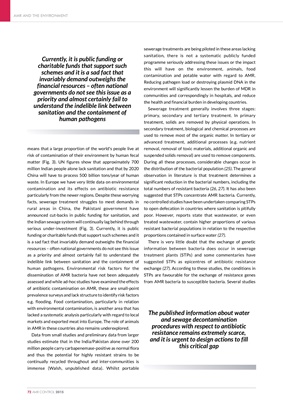
means that a large proportion of the world's people live at
risk of contamination of their environment by human fecal
matter (Fig. 3). UN figures show that approximately 700
million Indian people alone lack sanitation and that by 2020
China will have to process 500 billion tons/year of human
waste. In Europe we have very little data on environmental
contamination and its effects on antibiotic resistance
particularly from the newer regions. Despite these worrying
facts, sewerage treatment struggles to meet demands in
rural areas in China, the Pakistani government have
announced cut-backs in public funding for sanitation, and
the Indian sewage system will continually lag behind through
serious under-investment (Fig. 3). Currently, it is public
funding or charitable funds that support such schemes and it
is a sad fact that invariably demand outweighs the financial
resources - often national governments do not see this issue
as a priority and almost certainly fail to understand the
indelible link between sanitation and the containment of
human pathogens. Environmental risk factors for the
dissemination of AMR bacteria have not been adequately
assessed and while ad-hoc studies have examined the effects
of antibiotic contamination on AMR, these are small-point
prevalence surveys and lack structure to identify risk factors
e.g. flooding. Food contamination, particularly in relation
with environmental contamination, is another area that has
lacked a systematic analysis particularly with regard to local
markets and exported meat into Europe. The role of animals
in AMR in these countries also remains underexplored.
Data from small studies and preliminary data from larger
studies estimate that in the India/Pakistan alone over 200
million people carry carbapenemase-positive as normal flora
and thus the potential for highly resistant strains to be
continually recycled throughout and inter-communities is
immense (Walsh, unpublished data). Whilst portable
sewerage treatments are being piloted in these areas lacking
sanitation, there is not a systematic publicly funded
programme seriously addressing these issues or the impact
this will have on the environment, animals, food
contamination and potable water with regard to AMR.
Reducing pathogen load or destroying plasmid DNA in the
environment will significantly lessen the burden of MDR in
communities and correspondingly in hospitals, and reduce
the health and financial burden in developing countries.
Sewerage treatment generally involves three stages:
primary, secondary and tertiary treatment. In primary
treatment, solids are removed by physical operations. In
secondary treatment, biological and chemical processes are
used to remove most of the organic matter. In tertiary or
advanced treatment, additional processes (e.g. nutrient
removal, removal of toxic materials, additional organic and
suspended solids removal) are used to remove components.
During all these processes, considerable changes occur in
the distribution of the bacterial population (25). The general
observation in literature is that treatment determines a
significant reduction in the bacterial numbers, including the
total numbers of resistant bacteria (26, 27). It has also been
suggested that STPs concentrate AMR bacteria. Currently,
no controlled studies have been undertaken comparing STPs
to open defecation in countries where sanitation is pitifully
poor. However, reports state that wastewater, or even
treated wastewater, contain higher proportions of various
resistant bacterial populations in relation to the respective
proportions contained in surface water (27).
There is very little doubt that the exchange of genetic
information between bacteria does occur in sewerage
treatment plants (STPs) and some commentaries have
suggested STPs as epicentres of antibiotic resistance
exchange (27). According to these studies, the conditions in
STPs are favourable for the exchange of resistance genes
from AMR bacteria to susceptible bacteria. Several studies
AMR AND THE ENVIRONMENT
72 AMR CONTROL 2015
Currently, it is public funding or
charitable funds that support such
schemes and it is a sad fact that
invariably demand outweighs the
financial resources - often national
governments do not see this issue as a
priority and almost certainly fail to
understand the indelible link between
sanitation and the containment of
human pathogens
The published information about water
and sewage decontamination
procedures with respect to antibiotic
resistance remains extremely scarce,
and it is urgent to design actions to fill
this critical gap